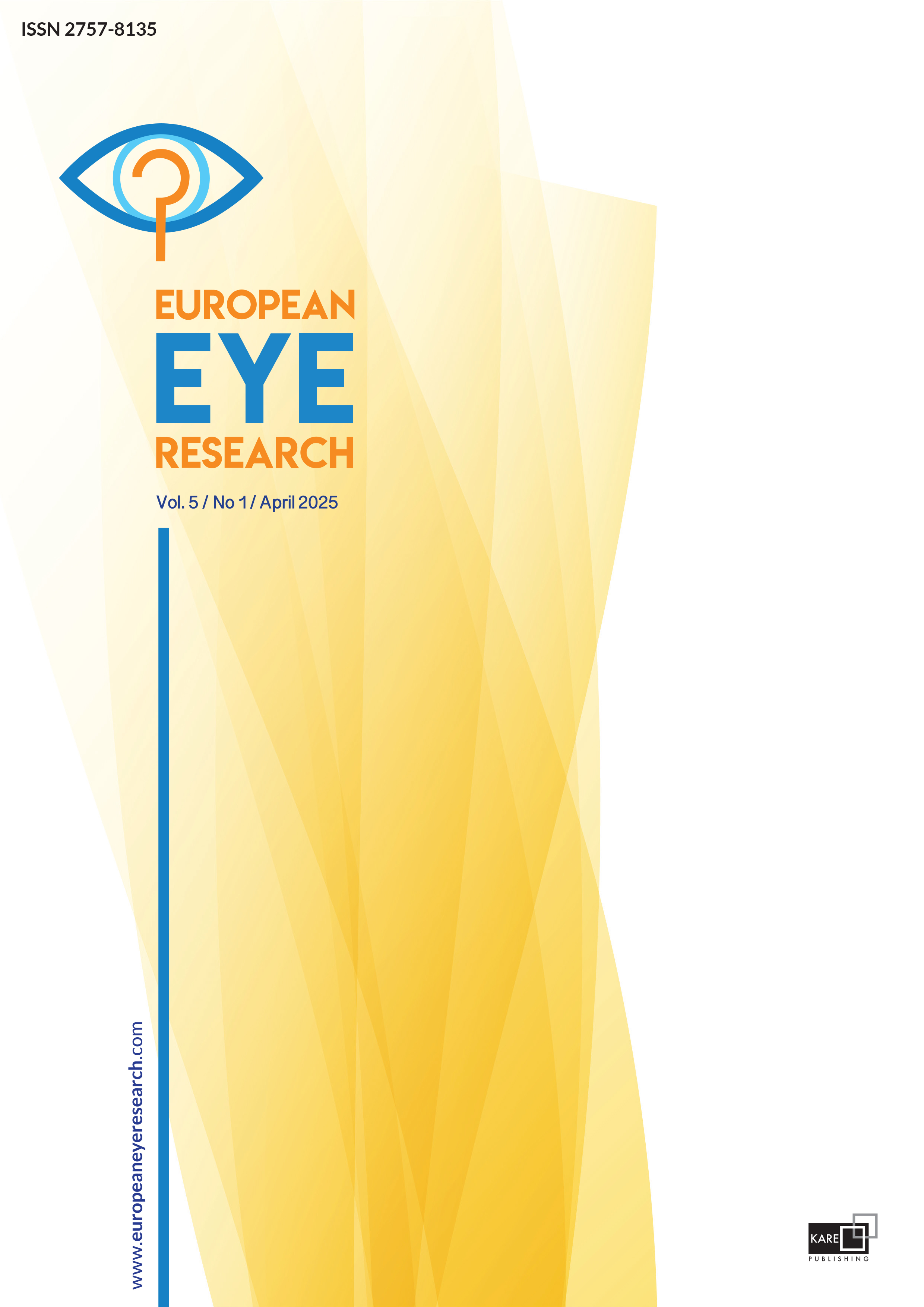

Volume: 4 Issue: 2 - 2024
| EDITORIAL | |
| 1. | Editorial Page I |
| FRONT MATTERS | |
| 2. | Front Matters Pages II - VIII |
| ORIGINAL RESEARCH | |
| 3. | Characteristics and frequency of pigmentary glaucoma in the Turkish population Yasemin Un, Oksan Alpogan, Ruveyde Bolac Unculu, Merve Beyza Yildiz, Cemile Aslan, Ece Turan Vural doi: 10.14744/eer.2023.72681 Pages 103 - 108 PURPOSE: To analyze the prevalence and characteristics of pigmentary glaucoma (PG) and pigment dispersion syndrome (PDS) in patients diagnosed at a tertiary center eye clinic in Türkiye. METHODS: This retrospective, single-center study was conducted at the glaucoma clinic of Haydarpaşa Numune Training and Research Hospital. The files of patients with glaucoma diagnoses between 2015 and 2023 were retrospectively reviewed. The prevalence of PG and PDS, characteristics of the patients, surgical requirements, applied surgical procedures, and risk factors for PG were analyzed. RESULTS: Of the 7,800 files that were reviewed, 50 (0.64%) belonged to patients with PDS or PG. The mean follow-up time was 41.45±34.56 months, and the mean age of the patients was 48.9±12.86 years. Twenty-five (50%) patients were male. Of the 100 eyes reviewed initially, 56 had PDS, 44 had PG, and 17 (30.3%) with PDS progressed to PG during the follow-up period. The mean spherical equivalent (SE) was –1.03±1.62 diopter. In the comparison of eyes with PDS and PG, there were no significant differences with regard to age, sex, SE, central corneal thickness, or best-corrected visual acuity. A median in-traocular pressure (IOP) of 17.5 mmHg was achieved on two median glaucoma medications at the last visit. Overall, 10 eyes with PG required surgical and laser interventions for IOP control. Laser peripheral iridotomy (LPI) was performed on nine of these eyes, trabeculectomy with antimetabolite augmentation on two (which had previously undergone LPI), and XEN® gel stent implantation on one. CONCLUSION: Among the glaucoma patients, the detected frequency of PDS and PG was 0.64%. We did not detect male dom-inance. The median SE was –1.03±1.62 diopter, indicating mild myopia, which is consistent with the literature. |
| 4. | Evaluation of deep sclerectomy and trabeculectomy in the treatment of glaucoma Serap Karaca, Halit Oguz, Mustafa Hepokur, Omer Faruk Yilmaz doi: 10.14744/eer.2023.30074 Pages 109 - 114 PURPOSE: This study aims to compare the clinical outcomes of deep sclerectomy and trabeculectomy surgeries, both utiliz-ing 5-fluorouracil METHODS: In this study, 11 eyes of 10 patients (14.3%) in the deep sclerectomy group and 66 eyes of 61 patients (85.7%) in the trabeculectomy group were retrospectively examined. Success in intraocular pressure (IOP) was defined as being below 21 mmHg without medication, partially successful if achieved below 21 mmHg with a single molecule, considered less success-ful with two to four molecules for maintaining IOP below 21 mmHg, and deemed unsuccessful if IOP exceeded 21 mmHg. RESULTS: The deep sclerectomy group showed a success rate of 81.8% on post-operative day 1, with 18.2% considered unsuccessful; at post-operative 6 months, the success rate was 12.5%, with 50% partially successful and 37.5% less successful. In the trabeculectomy group, the success rate was 97% on post-operative day 1, with 3% considered unsuccessful; at post-operative 6 months, the success rate was 60.8%, with 15.7% partially successful, 13.7% less successful, and 9.8% unsuccessful. Trabeculectomy patients experienced complications such as choroidal detachment (6.1%), shallow anterior chamber (4.5%), tight suturing (3%), internal ostium occlusion (3%), posterior synechia (3%), bleb failure (1.5%), cyclodialysis/iridodialysis (1.5%), and hyphema (1.5%). In the deep sclerectomy group, tight suturing (36.3%), and dellen (9.09%) were observed, with no other complications reported. CONCLUSION: Trabeculectomy surgery has been observed to be superior to deep sclerectomy in follow-ups up to 48 months postoperatively. However, it is noted that there is a higher risk of post-operative complications. |
| 5. | Evaluation of ocular surface features following corneal collagen cross-linking treatment in keratoconus patients: 24-month results Gozde Sahin Vural, Esin Sogutlu Sari, Alper Yazici, Cenap Guler doi: 10.14744/eer.2024.58070 Pages 115 - 121 PURPOSE: The aim of the study was to determine the effects of corneal collagen cross-linking (CXL) on tear function param-eters in a long-term period retrospectively. METHODS: Twenty-four eyes of 17 keratoconus patients after CXL treatment were included in the study. The ocular sur-face disease index questionnaire (OSDI), tear osmolarity, tear break-up time (T-BUT), Oxford ocular surface staining score, Schirmer I test, and the National Eye Institute Visual Function Questionnaire-25 were performed before and after CXL at 1st and 24th months. All parameters were compared. RESULTS: Tear osmolarity significantly increased during follow-up (p=0.001). The increment in T-BUT was significant between pre-operative and 1st month (p=0.001). Oxford grading score increased progressively but the difference was only significant between pre-operative and 24 months (p<0.05). Schirmer’s score improved at 1st month but altered in favor of dry eye at 24 months similar to T-BUT. OSDI and tear osmolarity were significantly increased in all visits (p<0.05). CONCLUSION: Dry eye disorder was demonstrated as a significant complication of CXL in keratoconic eyes in a long-term pe-riod. Even if we performed CXL at early times, we need to follow patients for ocular surface disorders as well as topographic progression for the period of long time because the side effects of CXL on the ocular surface last up to 24 months. |
| 6. | Vascular indexes of choroidal layers in diabetic macular edema Okan Akmaz, Gokhan Tokac, Murat Garli, Merve Cetin, Miray Karatas, Yusuf Ziya Guven, Bora Yuksel, Tuncay Kusbeci doi: 10.14744/eer.2024.42275 Pages 122 - 127 PURPOSE: This study aimed to investigate the presence of choroidal vascular parameters, which have a predictive value for diabetic macular edema (DME) development, in eyes with non-proliferative diabetic retinopathy (NPDR). METHODS: 148 eyes of 120 patients were included in the study. Eyes with an untreated mild-to-moderate NPDR stage were divided into 2 groups as those with and without DME. The diabetic retinopathy (DR) group was created from the eyes of patients diagnosed with diabetes mellitus without DR. Choroidal layers were segmented using the enhanced depth imag-ing mode of spectral domain optical coherence tomography. Choroidal vascular indexes (CVI) of the full-thickness choroid, sattler-choriocapillaris layer, and Haller’s layer were calculated separately. RESULTS: Full-thickness CVI values of the choroid were 65.2±3.1% in the DR-group, 64.2±3.4% in the DME-group, and 64.8±3.08% in the DME+ group (P = 0.318). The CVI values in the Sattler-choriocapillaris complex were 71.3±4.5% in the DR-group, 70.9±5.9% in the DME-group, and 71.7±5.2% in the DME+ group (P = 0.746). The CVI values in the Haller layer were 61.6±4.1% in the DR-group, 60.3±3.7% in the DME-group, and 61.1±3.1% in the DME+ group (P = 0.252). CONCLUSION: There was no significant difference between NPDR eyes with and without DME and eyes without DR in terms of CVI. These results may suggest that DME develops due to retinal vascular factors rather than choroidal vascular factors. |
| 7. | Aflibercept treatment with treatment-extend regimen in bevacizumab-resistant nAMD: Real-life experience Zubeyir Yozgat, Mehmed Ugur Isik doi: 10.14744/eer.2024.51523 Pages 128 - 134 PURPOSE: The aim of the study was to evaluate the anatomical and functional effectiveness of the treat-and-extend (TAE) regimen with intravitreal (IV) aflibercept treatment in neovascular age-related macular degeneration (nAMD) patients who responded anatomically poorly after three doses of IV bevacizumab injection. METHODS: This observational, single-center, real-life study included adults aged at least 50 years with treatment-naïve nAMD and a best-corrected visual acuity (BCVA) between 25 and 75 Early Treatment of Diabetes Retinopathy Study (ETDRS) letter scores. Three loading doses of IV bevacizumab were administered to all patients, and patients with an anatomical poor re-sponse after three loading doses were included in the study. All patients received three doses of IV aflibercept and treatment was continued with the TAE regimen. The primary endpoint was the mean change in BCVA from baseline to week 52. RESULTS: Thirty-six (48.6%) women and 38 (51.4%) men participated in this study, and the average age was 74.4±8.4 years. ETDRS letter gains were 5.5, 9.6, and 13.8 at weeks 12, 24, and 52, respectively. At week 52, a gain of 15 letters or more was detected in 34 of the patients (45.9%). The anatomical gains were 72.3 µm, 94.3 µm, and 116.7 µm at 12, 24, and 52 weeks, respectively. The mean number of injections performed was 8.2. The mean final interval was 8.8 weeks. The proportion of patients with 12 weeks or more between treatments was 16/74 (21.6%). CONCLUSION: In treatment-naïve nAMD patients refractory to bevacizumab, IV aflibercept administered using the TAE regi-men improved and maintained functional and anatomical outcomes for 52 weeks. |
| 8. | The relationship between color vision status and optical coherence tomography in the non-optic neuritis period in multiple sclerosis Betul Onal Gunay, Nuray Can Usta doi: 10.14744/eer.2024.41636 Pages 135 - 140 PURPOSE: To reveal the changes in the sense of color vision (CV) in Multiple Sclerosis (MS) patients in periods other than acute optic neuritis (ON) using the Ishihara test and to associate CV with optical coherence tomography (OCT) data. METHODS: The demographic and clinical data of MS patients were recorded retrospectively between 2016 and 2021. The CV of the patients was evaluated with the Ishihara test. Patients were grouped according to their CV status (Group 1: impaired CV, Group 2: normal CV). All patients were scanned with a spectral domain OCT device. Peripapillary retinal nerve fiber layer thickness (pRNFLT), macular thickness (MT), and retinal layer thicknesses were evaluated, and comparisons were made be-tween the groups. RESULTS: Fifty-eight eyes of 29 patients were included in the study. The mean age and expanded disability status scale scores were 37.6±9.1 years and 1.8±0.5, respectively. The CV impairment was detected in 5 eyes and was normal in 53 eyes. Com-paring Group 1 and Group 2, the ganglion cell layer thickness, inner plexiform layer thickness, MT, and pRNFLT were thinner, and the outer nuclear layer thickness was thicker in Group 1 (p<0.05). There was no difference between the two groups regarding the inner nuclear layer thickness, outer plexiform layer thickness, and retinal pigment epithelium layer thickness. CONCLUSION: The CV assessment with the Ishihara test can be performed easily, cost-effectively, and quickly by ophthalmol-ogists and neurologists, providing indirect information about the retina and optic nerve of the MS patient. |
| 9. | Turkish uveal melanoma research: A bibliometric analysis (1987–2024) Aslan Aykut, Almila Sarigul Sezenoz doi: 10.14744/eer.2024.42714 Pages 141 - 149 PURPOSE: The purpose of the study is to conduct a comprehensive bibliometric analysis of uveal melanoma (UM) research with a focus on Turkish contributions in both national and international literature. METHODS: A search, including Web of Science (WoS) Core Collection, Scopus, Turkish Database, and gray literature, including national thesis and TUBITAK project databases, was conducted without time limitation. Documents focused on UM research and had at least one author with a Turkish institution affiliation were included. Data were cleaned and analyzed using biblio-metric tools, including Open Refine and VOSviewer. Bibliometric data such as the number of publications, journals, authors,h-index, collaboration patterns, co-occurrence of keywords, citations, and the growth trends of publications were analyzed. RESULTS: The oldest and newest documents found were between 1987 and 2024. A total of 113 international (97 publications from WoS and 16 from Scopus) and 26 national publications (Turkish index) were included. The most common document type was the original research article (n=89, 78.76%) in international literature. The most represented journal was the Turkish Journal of Ophthalmology with (n=12, 10.62%) publications. A total of 16 theses with a publication rate of 56.5% were noted. Hacettepe University, Ankara University, and Istanbul University were the leading affiliations in UM research. Keyword analy-sis showed that Turkish UM research is predominantly focused on treatment modalities, and the genetic aspect of research is less represented. CONCLUSION: Our results highlight the dominance of a few academic centers and researchers on UM research, modest con-tribution to international literature, and potential research progression areas such as basic science and genetics research. |
| CASE REPORT | |
| 10. | A case report of Polish cochineal larvae infestation of eyelid Mehmet Canleblebici, Mehmet Balbaba doi: 10.14744/eer.2024.20982 Pages 150 - 153 The Polish cochineal (Porphyrophora polonica), a scale insect, has been integral to the textile and dye industries of Europe and Central Asia for centuries, prized for its ability to produce a vivid red dye. This insect, although commonly associated with its utility in historical dyeing practices, seldom crosses paths with the medical field. However, an unusual case report from Ak-dağmadeni, a region renowned for its dense oak and pine forests which create a conducive environment for ticks, highlights a rare intersection. In this case report, the Polish cochineal larva, which was mistakenly diagnosed as a tick, was removed from the eyelid of a 57-year-old female patient, and the allergic reaction it caused is presented. The case underscores this rare infestation with the significance of accurate diagnosis in the prevention of unnecessary medical interventions. |
| 11. | Bilateral immediately sequential endothelial keratoplasty in bilateral bullous keratopathy Tze Gee Ng, Omar Elhaddad doi: 10.14744/eer.2024.70188 Pages 154 - 157 Pseudophakic bullous keratopathy is the presence of persistent corneal edema following intraocular lens implantation or cataract surgery. A 75-year-old lady presented to us with a right failed descemet stripping automated endothelial kerato-plasty (DSAEK) performed elsewhere and a left eye with decompensating bullous keratopathy. A decision was made to proceed with a right DSAEK in the first instance. A second corneal graft became available due to a late cancellation. After further deliberation, the patient agreed to have the procedure done in both eyes. She received an immediate sequential bilateral endothelial keratoplasty with a DSAEK in the right eye and a descemet membrane endothelial keratoplasty in the left eye. This bilateral sequential endothelial keratoplasty resulted in faster bilateral visual recovery without complications. We postulate this as a viable option to speed bilateral visual recovery; accepting further evidence is required to support our assertion and help generate formal clinical guidance. |
| 12. | Longitudinal Follow-up after successful photodynamic therapy in two cases with unilateral choroidal hemangioma and serous macular detachment Denizcan Özizmirliler, Ali Osman Saatci doi: 10.14744/eer.2024.42204 Pages 158 - 164 Circumscribed choroidal hemangioma is a rare benign vascular choroidal tumor that may cause visual loss in regard to its location and/or be associated with either intraretinal or subretinal fluid leakage. We described the long-term good clinical outcome in two patients who underwent a single session of verteporfin photodynamic therapy (PDT) for the treatment of unilateral choroidal hemangioma and associated serous macular detachment with a follow-up duration of 13 and 14 years. PDT is a safe and effective therapy for the treatment of choroidal hemangioma and restores visual function in many cases without causing any apparent ocular or systemic side effects in the long run. |
| REVIEW ARTICLE | |
| 13. | Revolutionizing vision restoration: Unleashing the power of Bowman’s layer transplantation Betul Akbulut Yagci, Ezgi Karatas, Canan Asli Utine doi: 10.14744/eer.2023.41736 Pages 165 - 173 Bowman layer inlay and outlay transplantation is a cutting-edge surgical technique that has revolutionized the field of corneal transplantation. This novel technique entails the transfer of the Bowman layer, a slender layer of the cornea, with the purpose of rectifying diverse corneal abnormalities and enhancing visual results. The Bowman layer inlay and outward trans-plantation approach differs from typical corneal transplantation methods by specifically targeting and replacing the affected layer of the cornea, rather than replacing the whole cornea. This method has many benefits, including accelerated healing periods, less chance of rejection, and enhanced visual acuity. Bowman layer inlay and outlay transplanting is recommended for several corneal diseases and illnesses. Common indications for this operation include keratoconus, corneal dystrophies, corneal scarring, corneal ectasia, and corneal abnormalities. This article will examine the complexities of Bowman layer inlay and outward transplanting, its uses, and the possible advantages it provides to individuals with corneal diseases. Bowman layer inlay and outlay transplanting appropriateness for each unique instance is evaluated by a comprehensive review of the patient’s particular condition and demands. |



